Home
Aussie Bee Online
Welcome
New Articles
About Native Bees
Bee Photo Gallery
Bees in Your Area
Common Questions
Rescuing Native Bees
Exotic Bumblebees
What are Stingless Bees?
Buying Stingless Bees
Honey Production
Crop Pollination
Study Native Bees
Field Guide
Information Booklets
Tim Heard's Book
John Klumpp's Book
Aussie Bee Back Issues
Seminars
Links
Support Native Bees
Aussie Bee Shop
Order Form
Who We Are
Donations
Privacy Policy
Free Newsletter
Website Survey
Download Printer-Friendly PDF version of this article
When Bees Smell Like Trees:
Stingless Bees with Resinous Perfumes
by Dr Sara Diana LeonhardtUniversity of Würzburg, Germany
December 2010
Stingless bees collect pollen and nectar from flowers to feed themselves and their colonies. However, stingless bees also collect the sticky and often smelly saps (resins) that plants produce to ward off herbivores and microorganisms. In this article, Sara Leonhardt explains the amazing uses of resins by stingless bees in Australia and Borneo, that she discovered during her PhD studies.
I first saw a stingless bee collecting resin in Borneo while I was an undergraduate student at the University of Würzburg. I was intrigued how the bees could handle the sticky and toxic plant secretions and can even collect huge amounts of it: They easily transfer resin in their mandibles (or jaws) and on their legs, mix it with other substances (such as wax or soil) and incorporate it in their nest structures.
By contrast, even closely related hymenopterans, e.g. ants, simply get stuck when they get too close to the sticky stuff. Not surprisingly, bees use resins as defense against ants and other predators. They surround their nest entrances with sticky layers of fresh resin which successfully entangle intruders, or they directly put it on top of approaching enemies. They do not even spare curious researchers who put their noses too close to their nests and I frequently spent entire evenings desperately trying to remove resin from my hair.
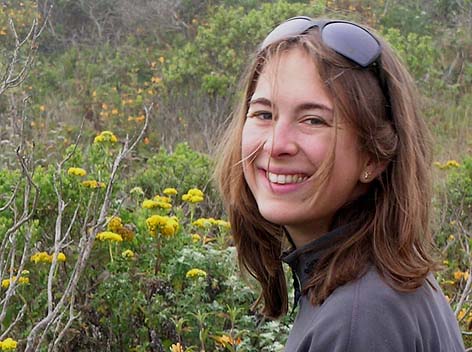 |
|
Researcher, Dr Sara Leonhardt of the University of Würzburg
|
The Research Begins in Borneo
When I first expressed my wish to study resin collection in stingless bees, my advisor simply laughed at me. However, I had gotten ‘stuck’ and, two years after I had had my first encounter with those resin collecting bees, I returned to Borneo, this time with enough money for a PhD on resin collection in stingless bees. I wanted to find out why, where and when the bees collected resin and how it influenced their chemical ecology.
Body Odors Help Bees Recognize Friends and Foes
Like all (social) insects, stingless bees have a highly sophisticated communication system and body odor plays a key role in this. Each species and even each colony has its own body odor. Because bees perfectly know the smell of their own species or colony, they can distinguish between their sisters, unrelated bees and bees from other species.
Even though we cannot detect these differences between different bees using our noses, we can identify different species and colonies by experimentally analyzing their odors in the laboratory. A bee’s body odor comes from a layer of chemical compounds whose basic purpose was to stop the bee’s body from drying out. Then as bees developed social colonies, these same compounds became involved in their communication systems. These compounds are built up of relatively long chains of carbon and hydrogen atoms. Chemists refer to them as aliphatic hydrocarbons.
The composition of chemical compounds from bee body odors or other samples (e.g. nest material) is studied by washing bees / nest pieces in a solvent to produce an extract. Then the bees / nest pieces are discarded. The pure extract is analyzed by gas chromatography (GC) and mass spectrometry (MS). GC separates different chemical compounds according to their size and polarity, and MS allows us to classify and sometimes identify the separated compounds.
Bees with Resin Perfumes
From a chemical point of view, resin is a quite complex substance with an enormous variety of chemical compounds. In Borneo, we analyzed the resin produced by a common group of trees called diptercarps. We discovered that some of the typical compounds found in this resin were also present on the local stingless bees – mixed with the bees’ natural body odors. The bees were not only using this resin as a nest building material and for defense; they were also blending it into their own body odors!
Fascinatingly, different bee species were able to select different sets of compounds from the resin. Hence, each bee species had its own resin perfume and could be distinguished from other species solely based on those chemical compounds that came from resin!
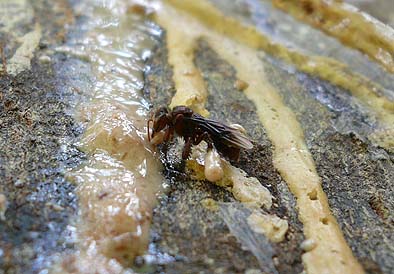 |
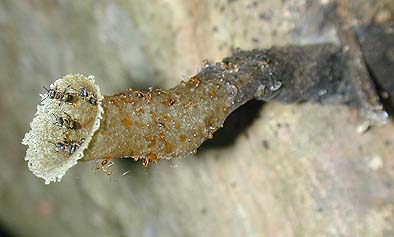 |
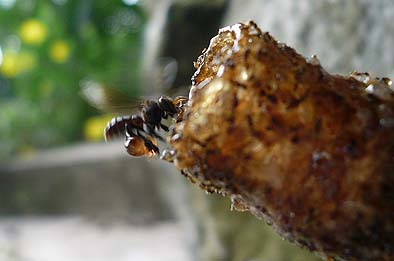 |
|
Top: A Tetrigona binghami bee collecting resin from a dipterocarp tree (Hopea nervosa) in Borneo. Centre: A nest of Lepidotrigona ventralis in Borneo that had been attacked by yellow crazy ants (Anoplolepis gracilipes). The attack was prevented by entangling ants with resin droplets. Above: A Tetragonilla collina forager returning with resin on its hindlegs in Borneo.
|
I wondered whether the presence of resin perfumes was a unique feature of the stingless bees of Borneo or whether it also occurred in stingless bees from other continents. To answer this question, I decided to extend my work to Australia and have a look at the bees ‘Down Under’.
Continuing the Research ‘Down Under’
The only problem was that I did not know anyone in Australia working on stingless bees. Thus, I contacted Ben Oldroyd in Sydney, whose name I had read on several publications. I told him about my idea and asked whether he knew people who might be willing to help me. Ben suggested that I contact Tim Heard.
This is how a German PhD student got to experience the striking helpfulness and hospitality of Australian stingless beekeepers; and it was thanks to Tim Heard and Helen Wallace that I met and got to collect bees in the backyards of Russell and Janine Zabel, Peter Davenport, Bob Lawn, and Lewis and Charlie Roberts. With the help of all these people, my sister (and field assistant) Lena and I managed to collect bees from Trigona and Austroplebeia colonies all along the Australian east coast.
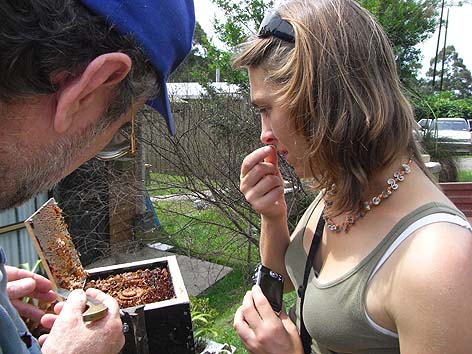 |
|
Sara Leonhardt smelling bees with Peter Davenport in Elanora, Queensland.
Photograph by Sara’s sister, Lena Leonhardt. |
The Australian Results
We found that the AusInterestingly, 51% of the resin-derived compounds on these Australian stingless bees were identical with compounds from resin produced in fruits of the cadagi tree, Corymbia torelliana. Our fruits secrete resin to attract resin foraging bees. While the bees collect resin, the seeds get attached to their body and the
erse
s. This unusu
ispe
melittochory, has been researched in some detail in C. torelliana by Dr Helen Wallace.
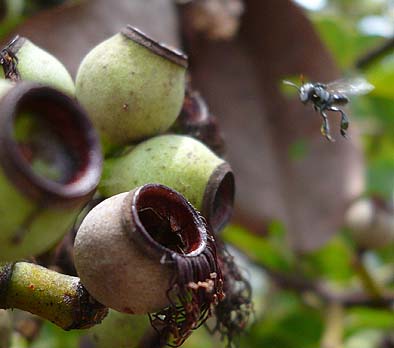 |
|
A Trigona carbonaria forager approaching the fruit of a cadagi tree (Corymbia torelliana) in Walkamin on the Atherton Tableland, Queensland.
|
Why do Bees Acquire Resin Perfumes?
As mentioned before, resin is a defensive secretion of plants. Its compounds can repel insects and even vertebrate animals and reduce the growth of bacteria and fungi. So, resin compounds on the bees’ bodies probably protect them
However, mere protection against enemies does not explain why different bee species blend different sets of resin compounds into their body odors. These special resin perfumes suggest that these resin compounds are probably involved in the bees’ communication system.
To test this hypothesis, I concentrated on several resin-derived compounds, called sesquiterpenes, that had varied the most amongst the bee species. I studied what effect these sesquiterpenes might have on aggression between colonies in one of the stingless bee species of Borneo.
This species did not have sesquiterpenes in its body odor. I coated a dead bee of this species with sesquiterpenes and tested the response of bees from a different colony to the coated bee. Normally these bees will aggressively attack a dead bee, if it is from a foreign colony, whereas they will at most touch a dead bee with their antennae, if it is from their own colony. However these bees did not attack foreign dead bees that were coated with sesquiterpenes.
This suggests that sesquiterpenes somehow reduce the normally aggressive behavior of stingless bees. Perhaps some stingless bees use resin-derived compounds to mask their own body odor, making them unrecognizable to other species, because such aggression can be costly to a bee colony.
Fascinating Questions for Future Research
We still do not know whether resin-derived compounds are used in communication amongst individuals of the same species. For instance, could these compounds help the bees recognize bees from different colonies, or distinguish workers from queens? It is also unclear how the bees acquire compounds from resin and transfer them to their body surface.
Furthermore, how do the bees avoid getting stuck in resin and how can they handle these chemical compounds that are highly toxic to most other insects? There is still plenty of work for future research on this tight relationship between stingless bees and resin secreting plants!
Further reading
Leonhardt SD & Schmitt T (2010) The cuticular profiles of Australian stingless bees are shaped by resin of the eucalypt tree Corymbia torelliana. Austral Ecology doi:10.1111/j.1442-9993.2010.02184.x.
Leonhardt SD, Blüthgen N & Schmitt T (2009) Smelling like resin: terpenoids account for species-specific cuticular profiles in Southeast-Asian stingless bees. Insectes Sociaux 56 (2): 157-170.
Leonhardt SD & Blüthgen N (2009) A sticky affair: resin collection by Bornean stingless bees. Biotropica 41 (6): 730-736.
Wallace HM & Lee DJ (2010) Resin-foraging by colonies of Trigona sapiens and T. hockingsi (Hymenoptera: Apidae, Meliponini) and consequent seed dispersal of Corymbia torelliana (Myrtaceae). Apidologie 41: 428-435.
Download the PDF version of this article.
(If you have not used PDF before, click here.)
• For more interesting Aussie Bee Online articles on native bees, visit the contents
.
|
Please feel free to print out this article or to email copies of the PDF version to your friends. This article may also be reproduced or hosted on other websites providing it is kept in its full and unaltered form including ANBRC contact details.
|
.
Search Aussie Bee Website:
© 1997-2018 Australian Native Bee Research Centre
PO Box 74, North Richmond NSW 2754, Australia